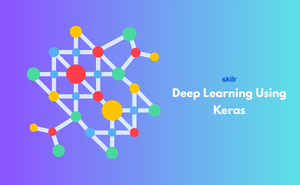👇 CELEBRATE CLOUD SECURITY DAY 👇
00
HOURS
00
MINUTES
00
SECONDS

Keras in Deep Learning provides a smooth entry point into the world of AI and neural networks. It is designed to simplify the process of creating models that can learn from data, making it possible for individuals with even basic Python knowledge to build powerful applications. Keras offers flexibility and efficiency, making it suitable for solving complex challenges in areas like speech recognition, medical diagnosis, and business forecasting.
To put it simply, Keras is like a friendly guide that takes care of the technical heavy lifting in deep learning. It allows learners and professionals to focus more on solving problems rather than worrying about coding complexity. With Keras, exploring deep learning becomes both accessible and practical.
This exam is ideal for:
Domain 1 - Introduction to Deep Learning and Keras
Domain 2 - Getting Started with Python and Keras
Domain 3 - Understanding Neural Networks
Domain 4 - Building Models with Keras
Domain 5 - Model Evaluation and Tuning
Domain 6 - Deep Learning Architectures in Keras
Domain 7 - Advanced Keras Features
Domain 8 - Applications of Keras in Real World
Industry-endorsed certificates to strengthen your career profile.
Start learning immediately with digital materials, no delays.
Practice until you’re fully confident, at no additional charge.
Study anytime, anywhere, on laptop, tablet, or smartphone.
Courses and practice exams developed by qualified professionals.
Support available round the clock whenever you need help.
Easy-to-follow content with practice exams and assessments.
Join a global community of professionals advancing their skills.
Anyone interested in AI, machine learning, or deep learning, including students, software developers, data scientists, and AI researchers.
Keras offers a user-friendly API, making it easier to build and train deep learning models without requiring extensive low-level coding.
Basic knowledge of Python and machine learning concepts is helpful but not mandatory, as Keras simplifies deep learning implementation.
Industries like healthcare, finance, robotics, autonomous systems, and entertainment leverage deep learning for AI-driven solutions.
It enhances expertise in neural networks, making professionals more competitive in AI and deep learning job markets.
Careers include machine learning engineer, data scientist, AI researcher, software developer, and deep learning specialist.
Keras is easier to use compared to low-level frameworks like TensorFlow and PyTorch, making it ideal for rapid prototyping.
Yes, Keras is widely used for applications such as image classification, natural language processing, recommendation systems, and predictive analytics.
Yes, mastering Keras helps professionals transition into AI roles by equipping them with practical deep learning skills.
Learners can explore advanced deep learning topics, work on AI projects, or dive deeper into TensorFlow for more complex implementations.